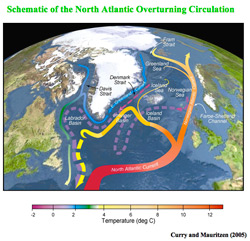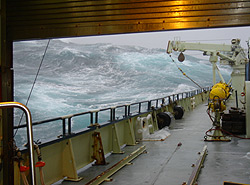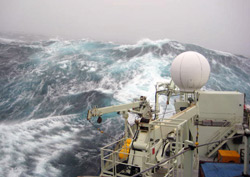Wind on the Water by Dallas Murphy
Good morning, all. At least it’s morning here in the Irminger Sea. Last night’s storm turned out not to be quite as severe or lengthy as predicted. The wind got up around 50 knots, but now it’s down in the mid 20s. (A knot as a measurement of speed equals 1.15 miles per hour or 1.8 kilometers per hour.) And the motion aboard wasn’t quite as mean as we’d expected. Sometimes it happens that way; sometimes it’s the opposite. In the broadest terms, the purpose of this expedition, and others like it, is to understand how nature works. This is an ocean-research vessel, but the ocean and the atmosphere make up a linked system that scientists call “air-sea interaction.” (Someone compared the air and the ocean to two coats of paint on the same billiard ball.) As everyone knows, when the wind blows, it makes waves, but like many things in nature’s systems, it’s more complicated than that. The size of the waves is determined by the speed of the wind. But if the wind, even when it’s strong, doesn’t last very long, then the waves won’t grow very high. So duration matters in wave formation. The third factor is the distance the wind blows over open water. In nautical language that’s called fetch. Say you’re at the beach and the wind is blowing from over the land onto the water—that will make for a nice flat-water swim. But surfers won’t like it. They want the wind to blow from over the sea; they want long fetch to make good (gnarly) waves. Now let’s extend this wind/water interaction out to the open-ocean scale and look at the formation of surface currents. (Please bear in mind that there are also currents running through the deep ocean, which we’ll get to later, but they are not generally caused by wind.) To cause an ocean current, the wind needn’t blow terribly hard, but it must blow consistently. The most famous consistent winds are the trade winds. In our hemisphere, the trades blow from east to west in the tropics. Christopher Columbus rode the trade winds from the Canary Islands (off the North African coast) to the New World, actually the Caribbean Sea. On his Second Voyage, he noticed that the east wind pushed a current westward. We now know it as the North Equatorial Current. North of the trade-wind belt at about the latitudes of New York and London, the wind blows in the opposite direction, from west to east. And that’s partly why the Gulf Stream heads east toward England when it leaves the coast of the United States. But the Gulf Stream itself doesn’t reach Europe. Rather, an offshoot of the Gulf Stream flows toward England. It’s called the North Atlantic Current (NAC), and it flows on past Britain, along the Norwegian coast and into the northern seas. Because the Gulf Stream comes up from tropical regions, the water is both salty and warm. When the west wind blows across the NAC, it carries the warmth onto the land. And that’s why Britain and Western Europe enjoy a milder climate than they deserve given how far north they are. These examples are limited to the North Atlantic, because the Irminger Sea is part of that ocean, but similar partnerships between wind and water influence climate all over the world. But for now, let’s just add these concepts to our vocabulary: 1) When it blows strongly enough and consistently, wind adheres to the surface of the ocean and forces it along, forming an ocean current. 2) Air and oceans collaborate to influence climate. The wind is down now, but the waves don’t know it yet. They’re slopping around all confused, coming, it seems, from five different directions at once. I’m not feeling so well, and I don’t think I’m alone in that aboard the good ship Knorr. Talk with you later…. Immap tarajoqassusia kiassutsillu ataqatigiinneri by Nick M?llerImartaq Danmarkstræde-mi tarajoqassusia kissassusaalu, silaannaap allanngoriartorneranut qanoq sinniuteqarnera malinnaavigineqarpoq. Imaq Island-p Tunullu sineriaata akornaniittoq ilisimatuunit asut soqutigineqarpoq, silaannaap kissatsikkiartornera ilutigalugu imeq sikorsuillu Danmarkstræde-mut pisartut annertusiartornerat, tamassumallu immap tarajoqassusaanut qanoq sunniuteqarnera pissanngatigineqarpoq. Sermersuarmiit Tunup sineriassuani kangerluit atorlugit sermersuit anisartut imaanut apuuffeqakkajupput, silaannaap kissatsikkiartorneranut sermersuit anisartut sunniuteqarnissaat ernumagivaat. Imap kiassusia piffissami kingullermi qaffakkiartorpoq, ilutigalugu tarajoqassuseq ukiuni kingullerni sanilliullugu annertusiartorluni. Tamakkuupput sermip iigartartup anianeranut sunniuteqarluarsinnaasut, tassami ukiumut sermeq iigartarroq ajornannginnerusumik Danmarstræde-mut appakaattalissaaq, immap kissakkiartorneranit sermip aattortarnera ajornannginnerulissammat. Ilisimatuut ernumassutigaat, Imaq Amerika-p kujataaniit Atlantikoq ikaarlugu Tuluit nuanaat Irland-nilu sinerlugit avannamut sarfartuartoq. Imaq sarfamit inerlaartilluni imeq aalannguulluni silaannarmut qaffattarpoq, imarlu ingerlaarnermini tarajoqassuseq annertusiartortarluni. Atlantikup avannaanut apuuttarpoq aallartiffimminiit tarajoqarnerulluni, Norge-p imartaani kaajallariarluni kujammut ingerlaqittarpoq. Island-nip avannaanut kujataanullu imaq Amerika-p kujataaneersoq tarajoqarluarluni, piffimmilu imartamiit kissarnerusarpoq. Sarfaq atuarlugu kujammut ingerlaalersarpoq imarlu tarajukitsoq nillertoq avannaanersoq naapittarlugu, taamaasilluni imaq tarajugissaartoq oqimaannerunini pissutigalugu immap naqqanut kivisarluni. Sermeq iigartartoq silaannaap kissakkiartorneranut aattortarnera innertusiartortillugu imaq tarajugissaartoq, tarajoqassusia annikillisittarlugu. Tarajorninnera annikippallaalissagaluarpat imaq Island-ip Tunullu akornaniittoq sarfamit angerlaarnera unittoorsinnaavoq, imarmi tarajoqarluartoq oqimaassutsimigut imartaq tarajukitsoq issigiinnalissagamiuk. Taannaavorlu ilisimatuut ernumassutigisaat, taamatummi pisoqassagaluarpat (istid) pinngorataarnissa ilimanaateqarluarmat. Taamatut pisoqassagaluarpat nunarsiarmi inuuniarneq allannguuteqangaatsiartussaavoq, istid-p kingulliup takutippaa Tuluit nunaat tikillugu sermersuusimasoq, tamannalu ulluni inooriutsimilu atukkatsinni ernummatigineqarluni taamatut pisoqarnissa. Last updated: October 17, 2008 | ||||||||||||||||||||||||
Copyright ©2007 Woods Hole Oceanographic Institution, All Rights Reserved, Privacy Policy. | ||||||||||||||||||||||||



